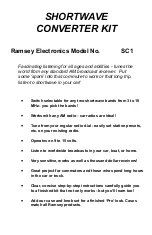
C MX 5710 Reference Manual. Rev 1.0
Page 28 of 36
Timing and Delays
The C MX 5710 provides a multitude of different timing options. Each audio input
and output path can be delayed as well as the video output path.
Video Timing Adjustments
By default, all video outputs deliver their SDI stream with a correct H/V alignment
to the REF signal. A manual additional User Delay can be applied to each SDI
output, offering an additional delay of up to a maximum of 62 additional video
frames. This manual user video delay is adjustable in one of two dimensions:
User Delay in Frames, Lines, Pixels.
The equivalent amount of Milliseconds
will be calculated (depending on the
current video standard) and displayed
as read-only value.
User Delay in Milliseconds.
The equivalent amount of Frames,
Lines and Pixels will be calculated
(depending on the current video
standard) and displayed as read-only
values.
When the current video standard changes (e.g. because a different source signal
is detected at the input), then the manual delay settings in the current dimensions
are kept constant, while the corresponding other dimension might change their
current values (depending on the current video standard).
NOTE:
The adjustable delay applied is in addition to the internal processing delay
of the module.
NOTE:
Adjusting the Video Output delay always delays embedded audio
contents together with the video content. Relative audio-video timing (aka
lip-sync) can only be influenced while audio and video are still kept on
independent paths. See
” below.
Audio Timing Adjustments
User Audio Delay values can be manipulated in the context of Audio Inputs (next
to the Audio Inputs on the left side of the GUI) as well as the Audio Outputs
(audio destinations on right side of GUI).
The main difference is the presence of the audio crossbar between those two
locations. The general recommendation is to correct for input-related timing
problems with the controls that are located at the inputs. And output-related
timing adjustments (e.g. compensating for a problem downstream) shall be
corrected with the output-related controls. Following this rule will make it easy to
operate the audio crossbars later, without having to re-adjust the timing
compensation afterwards.
Figure 23: Video Output Delay









































